Xuchao Zhang
AMPO: Active Multi-Preference Optimization
Feb 25, 2025Abstract:Multi-preference optimization enriches language-model alignment beyond pairwise preferences by contrasting entire sets of helpful and undesired responses, thereby enabling richer training signals for large language models. During self-play alignment, these models often produce numerous candidate answers per query, rendering it computationally infeasible to include all responses in the training objective. In this work, we propose $\textit{Active Multi-Preference Optimization}$ (AMPO), a novel approach that combines on-policy generation, a multi-preference group-contrastive loss, and active subset selection. Specifically, we score and embed large candidate pools of responses and then select a small, yet informative, subset that covers reward extremes and distinct semantic clusters for preference optimization. Our contrastive training scheme is capable of identifying not only the best and worst answers but also subtle, underexplored modes that are crucial for robust alignment. Theoretically, we provide guarantees for expected reward maximization using our active selection method, and empirically, AMPO achieves state-of-the-art results on $\textit{AlpacaEval}$ using Llama 8B.
Verifiable Format Control for Large Language Model Generations
Feb 06, 2025Abstract:Recent Large Language Models (LLMs) have demonstrated satisfying general instruction following ability. However, small LLMs with about 7B parameters still struggle fine-grained format following (e.g., JSON format), which seriously hinder the advancements of their applications. Most existing methods focus on benchmarking general instruction following while overlook how to improve the specific format following ability for small LLMs. Besides, these methods often rely on evaluations based on advanced LLMs (e.g., GPT-4), which can introduce the intrinsic bias of LLMs and be costly due to the API calls. In this paper, we first curate a fully verifiable format following dataset VFF. In contrast to existing works often adopting external LLMs for instruction-following validations, every sample of VFF can be easily validated with a Python function. Further, we propose to leverage this verifiable feature to synthesize massive data for progressively training small LLMs, in order to improve their format following abilities. Experimental results highlight the prevalent limitations in the format following capabilities of 7B level open-source LLMs and demonstrate the effectiveness of our method in enhancing this essential ability.
REFA: Reference Free Alignment for multi-preference optimization
Dec 20, 2024Abstract:We introduce REFA, a family of reference-free alignment methods that optimize over multiple user preferences while enforcing fine-grained length control. Our approach integrates deviation-based weighting to emphasize high-quality responses more strongly, length normalization to prevent trivial short-response solutions, and an EOS-probability regularizer to mitigate dataset-induced brevity biases. Theoretically, we show that under the Uncertainty Reduction with Sequence Length Assertion (URSLA), naive length normalization can still incentivize length-based shortcuts. By contrast, REFA corrects these subtle incentives, guiding models toward genuinely more informative and higher-quality outputs. Empirically, REFA sets a new state-of-the-art among reference-free alignment methods, producing richer responses aligned more closely with human preferences. Compared to a base supervised fine-tuned (SFT) mistral-7b model that achieves 8.4% length-controlled win rate (LC-WR) and 6.2% win rate (WR), our best REFA configuration attains 21.62% LC-WR and 19.87% WR on the AlpacaEval v2 benchmark. This represents a substantial improvement over both the strongest multi-preference baseline, InfoNCA (16.82% LC-WR, 10.44% WR), and the strongest reference-free baseline, SimPO (20.01% LC-WR, 17.65% WR)
SWEPO: Simultaneous Weighted Preference Optimization for Group Contrastive Alignment
Dec 05, 2024Abstract:We introduce Simultaneous Weighted Preference Optimization (SWEPO), a novel extension of Direct Preference Optimization (DPO) designed to accommodate multiple dynamically chosen positive and negative responses for each query. SWEPO employs a weighted group contrastive loss, assigning weights to responses based on their deviation from the mean reward score. This approach effectively prioritizes responses that are significantly better or worse than the average, enhancing optimization. Our theoretical analysis demonstrates that simultaneously considering multiple preferences reduces alignment bias, resulting in more robust alignment. Additionally, we provide insights into the training dynamics of our loss function and a related function, InfoNCA. Empirical validation on the UltraFeedback dataset establishes SWEPO as state-of-the-art, with superior performance in downstream evaluations using the AlpacaEval dataset.
Unveiling Context-Aware Criteria in Self-Assessing LLMs
Oct 28, 2024



Abstract:The use of large language models (LLMs) as evaluators has garnered significant attention due to their potential to rival human-level evaluations in long-form response assessments. However, current LLM evaluators rely heavily on static, human-defined criteria, limiting their ability to generalize across diverse generative tasks and incorporate context-specific knowledge. In this paper, we propose a novel Self-Assessing LLM framework that integrates Context-Aware Criteria (SALC) with dynamic knowledge tailored to each evaluation instance. This instance-level knowledge enhances the LLM evaluator's performance by providing relevant and context-aware insights that pinpoint the important criteria specific to the current instance. Additionally, the proposed framework adapts seamlessly to various tasks without relying on predefined human criteria, offering a more flexible evaluation approach. Empirical evaluations demonstrate that our approach significantly outperforms existing baseline evaluation frameworks, yielding improvements on average 4.8% across a wide variety of datasets. Furthermore, by leveraging knowledge distillation techniques, we fine-tuned smaller language models for criteria generation and evaluation, achieving comparable or superior performance to larger models with much lower cost. Our method also exhibits a improvement in LC Win-Rate in AlpacaEval2 leaderboard up to a 12% when employed for preference data generation in Direct Preference Optimization (DPO), underscoring its efficacy as a robust and scalable evaluation framework.
CREAM: Consistency Regularized Self-Rewarding Language Models
Oct 17, 2024



Abstract:Recent self-rewarding large language models (LLM) have successfully applied LLM-as-a-Judge to iteratively improve the alignment performance without the need of human annotations for preference data. These methods commonly utilize the same LLM to act as both the policy model (which generates responses) and the reward model (which scores and ranks those responses). The ranked responses are then used as preference pairs to train the LLM via direct alignment technologies (e.g. DPO). However, it is noteworthy that throughout this process, there is no guarantee of accuracy in the rewarding and ranking, which is critical for ensuring accurate rewards and high-quality preference data. Empirical results from relatively small LLMs (e.g., 7B parameters) also indicate that improvements from self-rewarding may diminish after several iterations in certain situations, which we hypothesize is due to accumulated bias in the reward system. This bias can lead to unreliable preference data for training the LLM. To address this issue, we first formulate and analyze the generalized iterative preference fine-tuning framework for self-rewarding language model. We then introduce the regularization to this generalized framework to mitigate the overconfident preference labeling in the self-rewarding process. Based on this theoretical insight, we propose a Consistency Regularized sElf-rewarding lAnguage Model (CREAM) that leverages the rewarding consistency across different iterations to regularize the self-rewarding training, helping the model to learn from more reliable preference data. With this explicit regularization, our empirical results demonstrate the superiority of CREAM in improving both reward consistency and alignment performance. The code is publicly available at https://github.com/Raibows/CREAM.
Building AI Agents for Autonomous Clouds: Challenges and Design Principles
Jul 16, 2024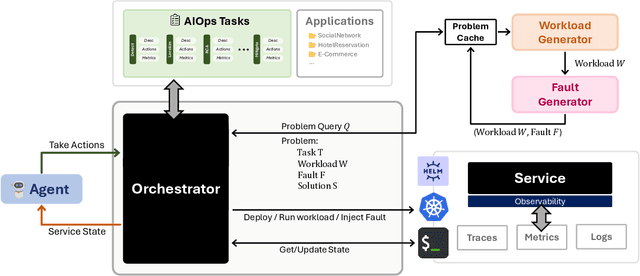
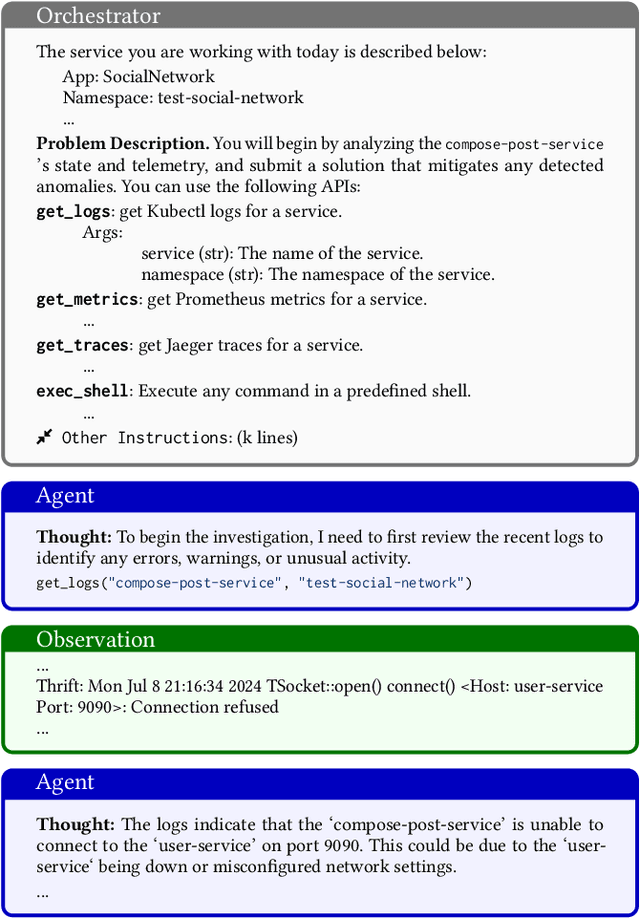
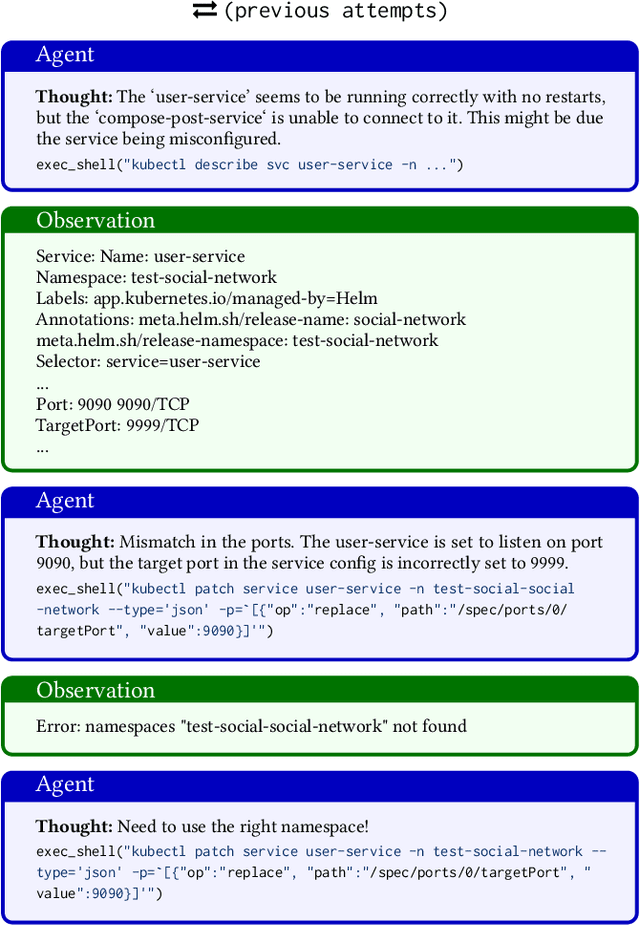
Abstract:The rapid growth in the use of Large Language Models (LLMs) and AI Agents as part of software development and deployment is revolutionizing the information technology landscape. While code generation receives significant attention, a higher-impact application lies in using AI agents for operational resilience of cloud services, which currently require significant human effort and domain knowledge. There is a growing interest in AI for IT Operations (AIOps) which aims to automate complex operational tasks, like fault localization and root cause analysis, thereby reducing human intervention and customer impact. However, achieving the vision of autonomous and self-healing clouds though AIOps is hampered by the lack of standardized frameworks for building, evaluating, and improving AIOps agents. This vision paper lays the groundwork for such a framework by first framing the requirements and then discussing design decisions that satisfy them. We also propose AIOpsLab, a prototype implementation leveraging agent-cloud-interface that orchestrates an application, injects real-time faults using chaos engineering, and interfaces with an agent to localize and resolve the faults. We report promising results and lay the groundwork to build a modular and robust framework for building, evaluating, and improving agents for autonomous clouds.
CARES: A Comprehensive Benchmark of Trustworthiness in Medical Vision Language Models
Jun 10, 2024

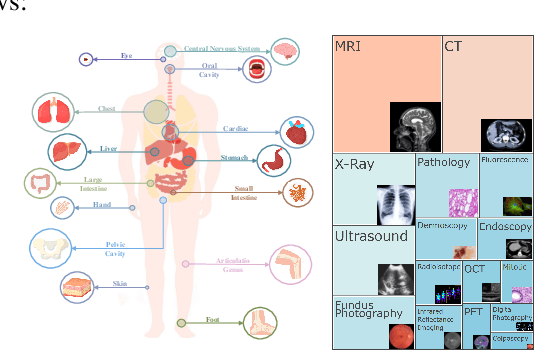
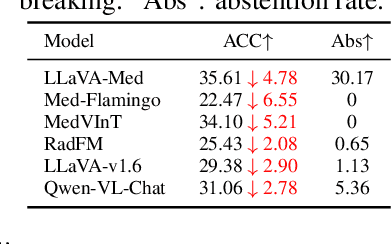
Abstract:Artificial intelligence has significantly impacted medical applications, particularly with the advent of Medical Large Vision Language Models (Med-LVLMs), sparking optimism for the future of automated and personalized healthcare. However, the trustworthiness of Med-LVLMs remains unverified, posing significant risks for future model deployment. In this paper, we introduce CARES and aim to comprehensively evaluate the Trustworthiness of Med-LVLMs across the medical domain. We assess the trustworthiness of Med-LVLMs across five dimensions, including trustfulness, fairness, safety, privacy, and robustness. CARES comprises about 41K question-answer pairs in both closed and open-ended formats, covering 16 medical image modalities and 27 anatomical regions. Our analysis reveals that the models consistently exhibit concerns regarding trustworthiness, often displaying factual inaccuracies and failing to maintain fairness across different demographic groups. Furthermore, they are vulnerable to attacks and demonstrate a lack of privacy awareness. We publicly release our benchmark and code in https://github.com/richard-peng-xia/CARES.
Exploring LLM-based Agents for Root Cause Analysis
Mar 07, 2024Abstract:The growing complexity of cloud based software systems has resulted in incident management becoming an integral part of the software development lifecycle. Root cause analysis (RCA), a critical part of the incident management process, is a demanding task for on-call engineers, requiring deep domain knowledge and extensive experience with a team's specific services. Automation of RCA can result in significant savings of time, and ease the burden of incident management on on-call engineers. Recently, researchers have utilized Large Language Models (LLMs) to perform RCA, and have demonstrated promising results. However, these approaches are not able to dynamically collect additional diagnostic information such as incident related logs, metrics or databases, severely restricting their ability to diagnose root causes. In this work, we explore the use of LLM based agents for RCA to address this limitation. We present a thorough empirical evaluation of a ReAct agent equipped with retrieval tools, on an out-of-distribution dataset of production incidents collected at Microsoft. Results show that ReAct performs competitively with strong retrieval and reasoning baselines, but with highly increased factual accuracy. We then extend this evaluation by incorporating discussions associated with incident reports as additional inputs for the models, which surprisingly does not yield significant performance improvements. Lastly, we conduct a case study with a team at Microsoft to equip the ReAct agent with tools that give it access to external diagnostic services that are used by the team for manual RCA. Our results show how agents can overcome the limitations of prior work, and practical considerations for implementing such a system in practice.
Uncertainty Decomposition and Quantification for In-Context Learning of Large Language Models
Feb 15, 2024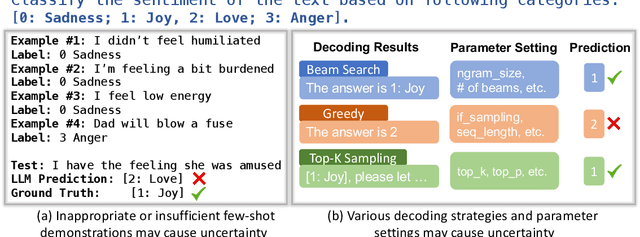
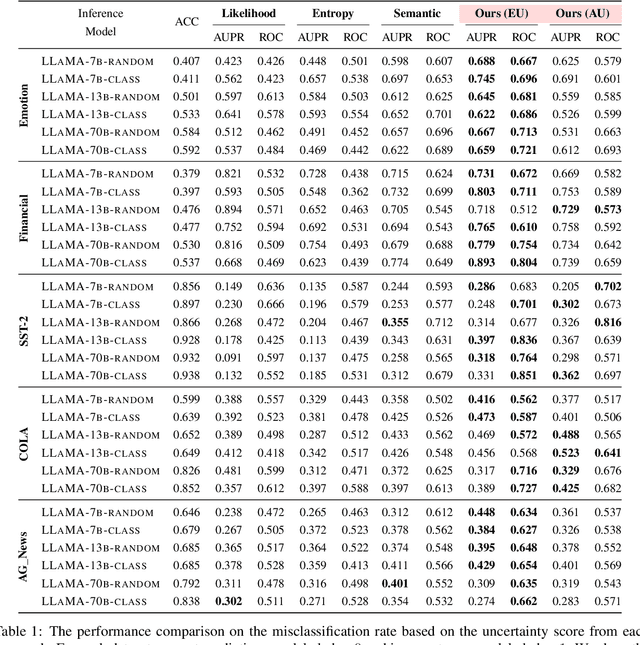
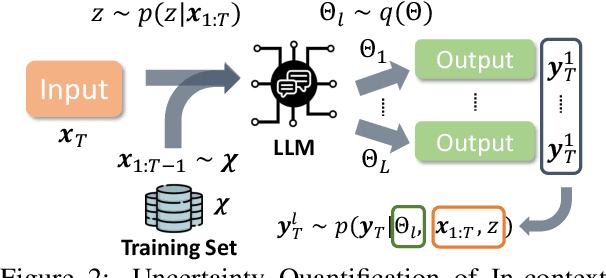
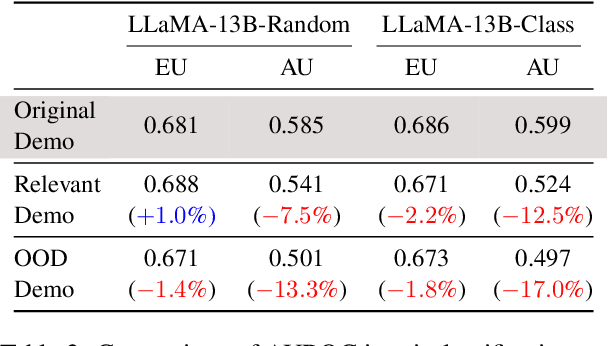
Abstract:In-context learning has emerged as a groundbreaking ability of Large Language Models (LLMs) and revolutionized various fields by providing a few task-relevant demonstrations in the prompt. However, trustworthy issues with LLM's response, such as hallucination, have also been actively discussed. Existing works have been devoted to quantifying the uncertainty in LLM's response, but they often overlook the complex nature of LLMs and the uniqueness of in-context learning. In this work, we delve into the predictive uncertainty of LLMs associated with in-context learning, highlighting that such uncertainties may stem from both the provided demonstrations (aleatoric uncertainty) and ambiguities tied to the model's configurations (epistemic uncertainty). We propose a novel formulation and corresponding estimation method to quantify both types of uncertainties. The proposed method offers an unsupervised way to understand the prediction of in-context learning in a plug-and-play fashion. Extensive experiments are conducted to demonstrate the effectiveness of the decomposition. The code and data are available at: \url{https://github.com/lingchen0331/UQ_ICL}.
 Add to Chrome
Add to Chrome Add to Firefox
Add to Firefox Add to Edge
Add to Edge